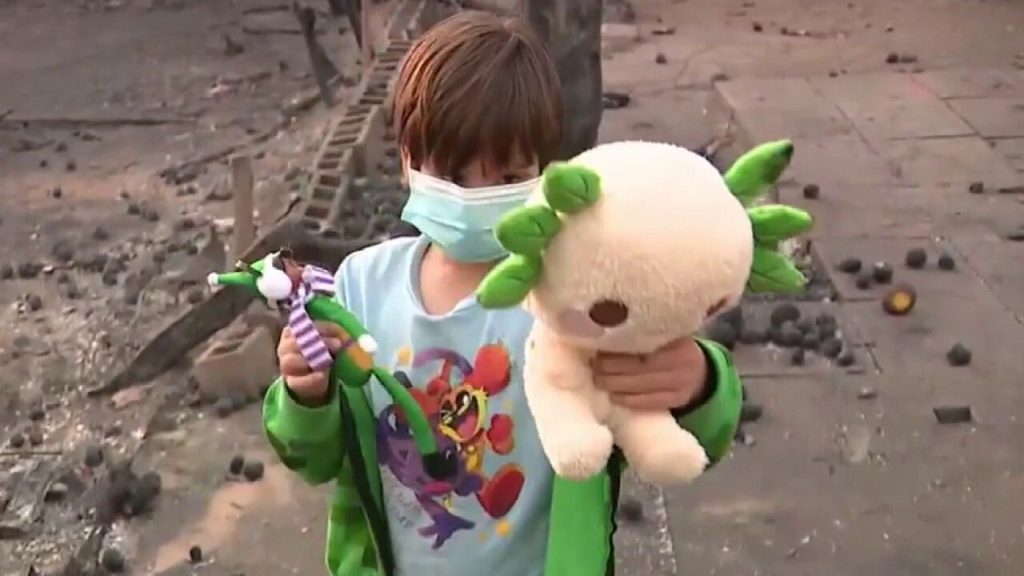The devastating wildfires sweeping through Southern California have left a trail of destruction, impacting thousands of lives and properties. While the media spotlight often focuses on the losses suffered by celebrities, the story of one family in Altadena poignantly illustrates the profound impact of these disasters on ordinary people. Their home, along with countless others, was reduced to rubble and ashes, leaving them with only the clothes on their backs and a handful of salvaged possessions. A young boy from the family, interviewed amidst the charred remains of his neighborhood, bravely recounted the terrifying moments of evacuation, clutching the only two items he managed to save: remnants of his parents’ bicycles. His innocent words, expressing both sadness and bewilderment at the loss of his cherished 3D printer and the familiar comfort of his home, serve as a stark reminder of the human cost of these natural disasters. The loss of their chimney, he poignantly notes, means Santa Claus won’t be able to visit their home anymore. This simple observation encapsulates the profound sense of displacement and disruption that these fires have inflicted on countless families.
The boy’s mother, in a heartfelt social media post, described the overwhelming pain of losing everything they had worked so hard for. The speed with which the fire engulfed their neighborhood, fueled by ferocious Santa Ana winds, left them with little time to salvage their belongings. They escaped with their children and two dogs, finding refuge in a downtown Los Angeles hotel. While grateful to be safe, the emotional toll of the loss is palpable. The new 3D printer, a long-awaited acquisition, symbolizes the material and emotional investments lost in the blaze. Her words echo a sentiment shared by many fire victims: while survival is paramount, the heartbreak of losing one’s home, possessions, and memories cannot be understated.
The Altadena family’s story is just one of thousands unfolding across Southern California as the wildfires continue to rage. The Eaton Fire, burning in the Pasadena-Altadena area, is one of several blazes threatening homes and businesses. Tens of thousands of acres have been scorched, and thousands of structures remain at risk. Firefighters are battling relentlessly against the inferno, hampered by the strong Santa Ana winds that fan the flames and create unpredictable fire behavior. The scope of the destruction is staggering, with insured losses potentially reaching record levels. The financial and emotional toll on individuals, families, and communities will be felt for years to come.
Beyond the immediate loss of homes and possessions, the wildfires have also disrupted lives in countless other ways. Families are displaced, living in temporary shelters or with relatives, facing uncertainty about their future. Children are uprooted from their schools and routines, their sense of security shattered. Businesses are destroyed, impacting livelihoods and local economies. The fires have also taken a toll on the environment, scorching vast tracts of land, destroying wildlife habitats, and releasing harmful pollutants into the air. The long-term consequences of this ecological damage are still being assessed.
In the face of such widespread devastation, communities are coming together to support those affected. Donations of food, clothing, and other essential supplies are pouring in. Volunteers are offering their time and resources to help with relief efforts. The outpouring of support demonstrates the resilience and compassion of the human spirit in times of crisis. However, the road to recovery will be long and arduous. Rebuilding homes, businesses, and lives will require sustained effort and resources.
The California wildfires serve as a stark reminder of the increasing threat posed by extreme weather events in a changing climate. Drought conditions, fueled by rising temperatures, create tinderbox landscapes that are highly vulnerable to wildfires. As these conditions become more prevalent, the risk of catastrophic fires increases. Addressing this challenge requires a multi-pronged approach, including proactive measures to reduce fuel loads in forests and wildland areas, strengthening building codes to enhance fire resistance, and investing in early warning systems and firefighting resources. Ultimately, mitigating the long-term risks of wildfires requires a global commitment to addressing climate change and promoting sustainable land management practices.

